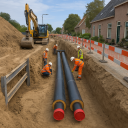Renewable energy supply – such as solar and wind power – is growing and the energy supply coming from gas fired power plants is decreasing.
City-zen was an international consortium, a program stimulating learning-by-doing in Grenoble and Amsterdam between March 2014 and November 2019. The results can be found in a booklet or in detailed reports. http://www.cityzen-smartcity.eu/home/reporting/deliverables/
What is the goal of the project?
A model for a regional smart energy platform
Renewable energy supply – such as solar and wind power – is growing and the energy supply coming from gas fired power plants is decreasing. Although this is great news for the planet, it also has a downside: volatility in the energy market. The supply of solar and wind power is unpredictable (unlike the supply of gas fired plants). The growing fluctuations in energy supply are affecting energy prices drastically. Which sometimes even results in negative energy prices. This especially affects ‘must-run’ installations with unpredictable power delivery such as waste-to-energy plant AEB.
As the aim is to maximize production and consumption of renewables in the Port of Amsterdam region, AEB needs a strategy. Following the trias energetica, the aim is to first look into a more balanced and smarter management of existing energy supply and demand before exploring energy storage possibilities. Therefore AEB, in cooperation with Alliander’s spin-off Energy Exchange Enablers, the Port of Amsterdam and other consumers in the PoA , is developing a model for a regional smart energy platform which balances unpredictable energy supply (such as wind, solar or waste power) with flexible demand (such as polder pumping).
PortREX tool:
To demonstrate this model, a pilot will be set up with some big consumers in the Port of Amsterdam who are flexible in their energy demand such as Waternet for its polder pumping and others for their cold storage warehouses. With the help of an operating system called PortREX (Realtime Energy Exchange) their energy consumption will be balanced; spreading it throughout the day or week when energy prices are low. In addition AEB will expand its flexibility – switching between its heat and electricity production – from a day-night rhythm to operating it on an hourly bases, balancing the wind and solar power produced on the local network. This will result in an improvement of economic efficiency of the system and maximize the consumption of local produced renewable energy
What is the result of the project?
Predict and act on volatility:
The aggregated data from PortREX, combined with the data from the regional smart energy platform, will enable AEB to predict and act on price volatility and, once the optimum balance is achieved, the need to invest in energy storage facilities.
Who initiated the project and which organizations are involved?
AEB, Energy Exchange Enables (ExE) / Alliander, Port of Amsterdam





